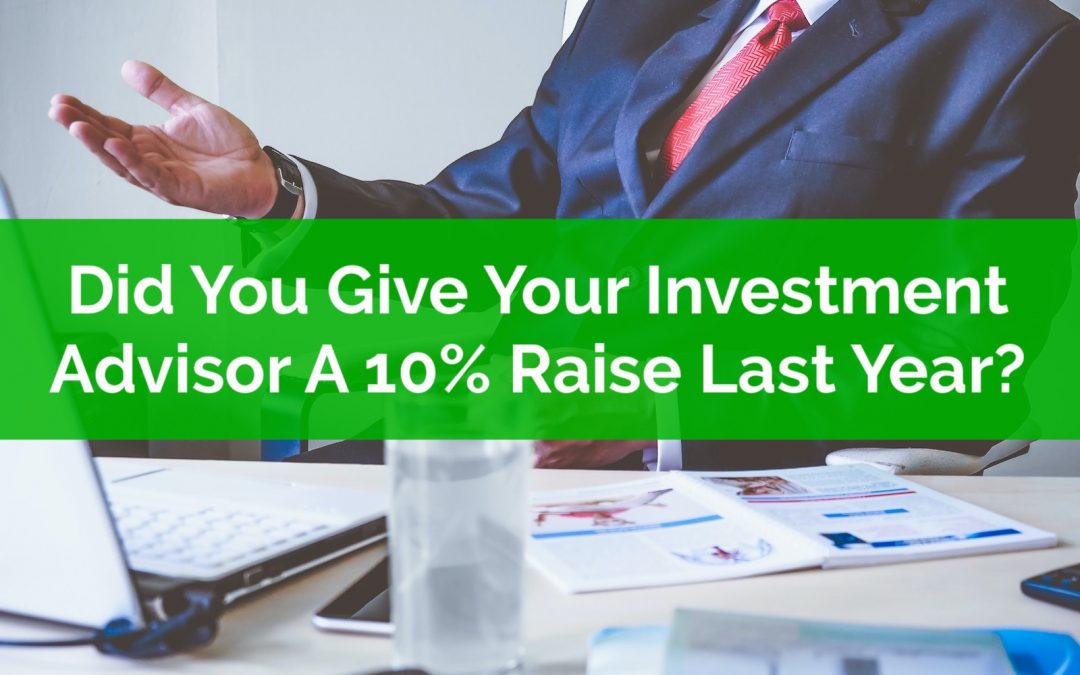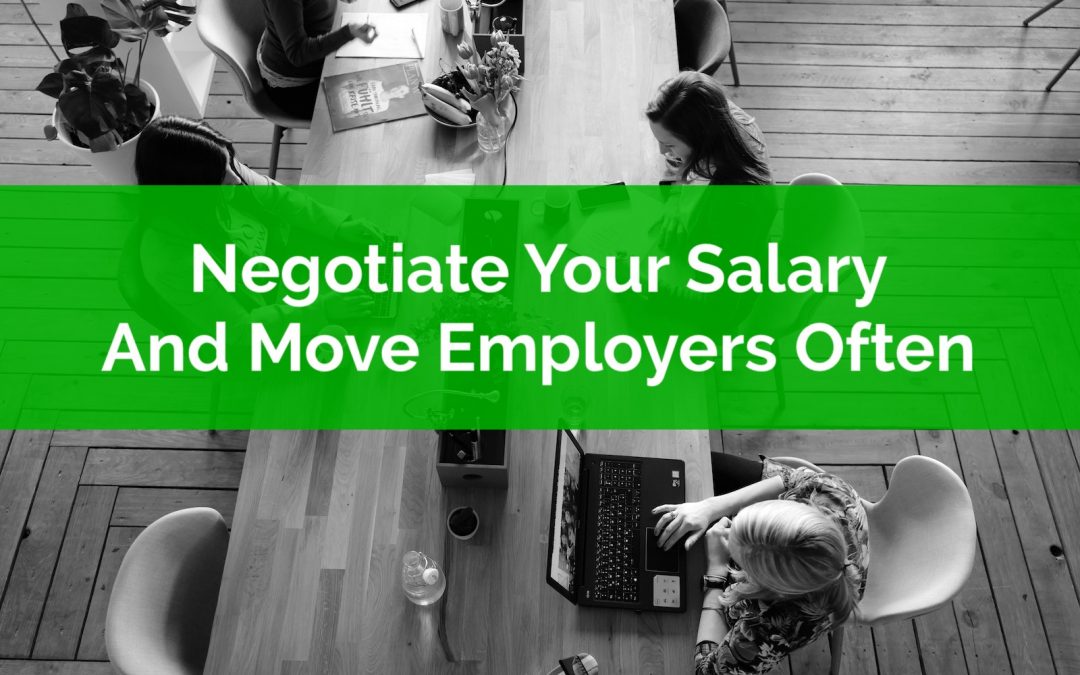
by Owen | Feb 15, 2021 | Investment Planning, Saving Money
Did you give your investment advisor a 10% raise last year? How generous of you!
With many investment advisors and portfolio managers compensated based on assets under management (AUM), an increase in portfolio value translates directly into an increase in compensation.
Despite the tumultuous year, investment returns pulled off an incredible recovery and ended the year much higher. Bonds, Canadian equities, US equities, Global equities, all higher than the year before. If you were holding VGRO or XGRO (two all-in-one ETFs with an 80/20 allocation) your portfolio would have grown 10.89% or 11.42% respectively.
With investment returns of 10%+ year over year that also means investment advisors are being paid more in 2021 than in 2020. How much more? Well, if their investment returns matched the market then their fees would also increase 10%+ in 2021.
Although there are many forms of compensation, many investment advisors and portfolio managers make a percentage of the portfolios that they manage. This could be 1.5% to 2.5%+ for smaller portfolios, 1.0% to 1.5% for portfolios of $1M to $2.5M, and under 1% for large portfolios of $2.5M+.
If portfolio values are 10% higher year over year, then these investment advisors and portfolio managers just received a 10% raise!

by Owen | Jan 18, 2021 | Behavioral Finance, Financial Planning, Investment Planning, Saving Money
Technically compounding begins with the first dollar, but when does compounding exactly take hold, when do we really start to FEEL the effect of compounding?
Compounding is almost like magic. It turns even the smallest amount of money into millions if given enough time.
Ben Franklin bequeathed $2,000 to the cities of Boston and Philadelphia in his will BUT with the stipulation that they could not draw on the investments for 200-years. The original amount has compounded over 200-years from $2,000 to $6.5 million!
But do you have to wait for 200-years to feel the effect of compounding? Definitely not.
The effect of compounding can be SEEN almost immediately but to really FEEL the effect of compounding takes at least a few years, plus, as well see below, it also depends on the rate of investment return.

by Owen | Nov 2, 2020 | Buying A Home, Down Payment, Financial Planning, Get Out Of Debt, Saving Money
It’s a challenging time for new graduates. The employment environment is difficult in many sectors/industries, plus the cost of rent and housing have outpaced inflation for years and years. It can feel very daunting to leave post-secondary when faced with mediocre job prospects and sky-high housing costs.
In some situations, the “bank of mom and dad” will step in and provide support. But, for the majority of families, that isn’t an option.
So how can parents help provide new grads a “leg up” in this challenging time?
More and more parents are inviting their adult children back home for 1-2 years after graduating to help them save money and pay off debt.
It may not be a cash gift, but it can provide nearly the same advantage.
Living at home to save money is a strategy that is on the rise. Parents are encouraging their children to take advantage of this opportunity and more and more adult children are doing it.
Living at home after graduation creates the opportunity to save $20,000, $30,000 or $40,000+ in one year, an opportunity that may never happen again.
Living at home for 1-2 years provides a huge head start for a new grad. This head start can be used to pay down student debt, build an emergency fund, start investing, buy a house etc. etc.
But it’s not all positive though. Living at home for a couple years also has risks. Without having a strategy in place it’s very easy to succumb to pitfalls like lifestyle inflation etc.
Here’s why parents should encourage their adult children to live at home for a couple years after graduation, and why new grads should seriously consider taking advantage.

by Owen | Oct 5, 2020 | Financial Goals, Financial Planning, Income, Saving Money
One of the most important pieces of a financial plan is income. Without an income it’s simply impossible to achieve any financial goals. Plus, having a higher income makes financial goals significantly easier to achieve.
While expenses often get a lot of focus because they’re entirely within our control, the fact is that without a certain level of household income it becomes much harder to save, invest, and still cover monthly spending.
This is why income, and specifically how income changes, should be an important part of every financial plan. Increasing income over time will make financial goals significantly easier to achieve, it makes debt payments a smaller proportion of net income, and it makes it possible to juggle competing priorities.
But unlike spending, income is unfortunately not completely within our control.
Increasing your annual income can be done a number of different ways. There are “side hustles”, there are second jobs, there is semi-passive income from rental properties etc. etc.
But the best and easiest way to increase income is to get paid more for what you’re already doing. You’re already at work, why not get paid more for doing the same thing?!? No “side hustle” required. No extra work. No stress of rental properties and bad tenants.
Increasing income is quite common, especially in a persons early 20’s and 30’s. On average income increases 7% per year during this phase. Once we reach our 40’s the pace of increases starts to slow down but those 15-20 years of steady increases can make a big difference.
How do you get salary increases of 7% per year (on average)? It takes a few things to make it easier, negotiating your salary is one, and unfortunately, switching employers often is another.
How impactful is increasing your income? Massive. In our example below, over a person’s working career, it’s equal to about $585,000 or 20,000 hours of extra work.
So, what would you prefer? Negotiating your salary every few years? Or putting in an extra 20,000 hours work (or about 10 years!)

by Owen | Sep 28, 2020 | Behavioral Finance, Financial Goals, Financial Planning, Retirement Planning, Saving Money
Financial Independence Retire Early (aka FIRE) is one of those big personal finance goals that has gotten a lot of attention recently. The idea of being financially independent, choosing when and if to work, is attractive for many people, especially when there is so much uncertainty in the world.
To be financially independent means that your investments (whether that be stocks, bonds, GICs, real estate etc) can provide enough income to cover annual expenses indefinitely. FIRE enthusiasts typically use the 4% rule as a guideline for how much income they can generate from their portfolio each year. The idea being that a person can draw 4% of their initial portfolio balance, adjusted for inflation each year, and have reasonably high chance of not running out of money after 30-years.
By using the 4% rule we can generate a rough target for FIRE. The basic idea is that you can take your annual expenses and multiply by 25 and that is your “FIRE number“. This is the amount needed in investments to safely retire early (although with low interest rates and low bond returns at the moment this rule is often thought to be too risky).
But despite it being a simple concept, reaching FIRE is a difficult task. It requires a high savings rate, low expenses, and lots of time.
FIRE is made easier with an above average income, which allows for a higher savings rate, but it is still a difficult task. Reaching FIRE means living well below your means for an extended period of time.
This combination of low spending, high savings, and a long time frame can lead to what’s known as “the boring middle”.
In this post we’ll briefly explain what FIRE is, why it’s so easy in the beginning, and why “the boring middle” could be a sign that there is an imbalance in the plan, one where the means may not justify the end.

by Owen | Aug 31, 2020 | Behavioral Finance, Emergency Fund, Retirement Planning, Saving Money
Out of all the ‘best practices’ in personal finance, emergency funds are probably the simplest and most effective. There is nothing easier to set up and nothing that provides more peace of mind than an emergency fund.
Emergency funds are boring, they are simple, and they hopefully never get used.
The purpose behind an emergency fund is simple. An emergency fund should provide quick access to cash in the event of an emergency. An emergency should be something truly unexpected like a job loss, a health emergency, an unexpected repair, an accident etc. Using an emergency fund for an expected expense is NOT the right way to use an emergency fund (more on that later).
Emergency funds can also be called an ‘e-funds’, ‘rainy day’ funds, or ‘oh $h!t’ funds. Whatever you call it, the purpose is the same, to help ease the financial burden during an emergency.
Yet, as simple as emergency funds are, they sometimes get used incorrectly. In this post we explore what an emergency fund is, how to set one up, how large it should be, and what NOT to do with an emergency fund.






